Foreign-born people and their descendants - labour market conditions
Data extracted June 2023.
Planned article update: June 2024.
Highlights
In the EU, the share of native-born employed persons working part-time, with both parents also native-born, was 15.5% in 2022. This rate was higher for foreign-born persons and for immediate descendants of foreign-born persons, at around 22–23%.
In the EU, 11.6% of employees who were native-born persons with two native-born parents were employed with a contract of limited duration in 2022. This share was higher for foreign-born persons and their immediate descendants, reaching 18.1% for foreign-born persons.
For native-born persons with two native-born parents, the share of self-employed persons in the EU in 2022 was 13.9%. This was lower for foreign-born persons and their immediate descendants: a share of 9.5% was recorded among native-born persons with two foreign-born parents.
The share of employed persons with an elementary occupation in the EU in 2022 was around 5–7% for native-born persons, regardless of the country of birth of their parents. For foreign-born persons, the share was 18.4%.
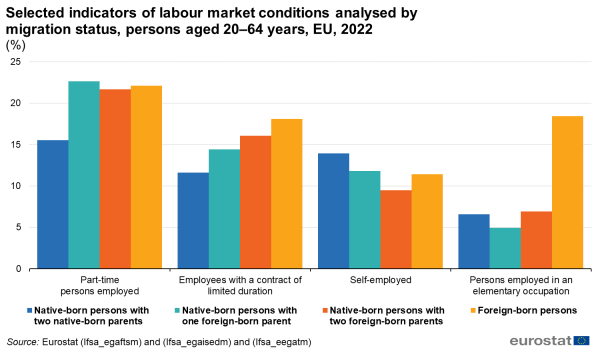
(%)
Source: Eurostat (lfsa_egaftsm) and (lfsa_egaisedm) and (lfsa_eegatm)
This article is one of a set of statistical articles concerning foreign-born people and their immediate descendants in the EU. This article forms part of an online publication. It presents statistics on the labour market conditions of persons usually residing in private households in the European Union (EU). The main focus is on people aged 20–64 years and relates to four types of labour market participation: part-time work, employment under a contract of limited duration, self-employment and employment in various occupations.
Persons living in private households can be categorised in terms of their migration status as:
- native-born with two native-born parents,
- native-born descendants of at least one foreign-born parent,
- native-born descendants of one foreign-born parent,
- native-born descendants of two foreign-born parents,
- foreign-born persons.
An article on the main characteristics of people by migration status (based on the EU-LFS data) provides information on the relative size of these categories.
Full article
Overview
The EU Labour Force Survey is the source of data for this article. For analyses of the labour market conditions, the broadest age range typically used is 15–74 years. The main focus of this article is the age group 20–64 years. This age group is of particular interest as it is the focus for employment analyses in the Action Plan on Integration and Inclusion 2021–2027.
Four indicators of employment conditions are presented in this article:
- The share of part-time persons employed among all persons employed.
- The share of employees with a contract of limited duration among total number of employees.
- The share of self-employed among all persons employed.
- The share of persons employed in an elementary occupation among all persons employed.
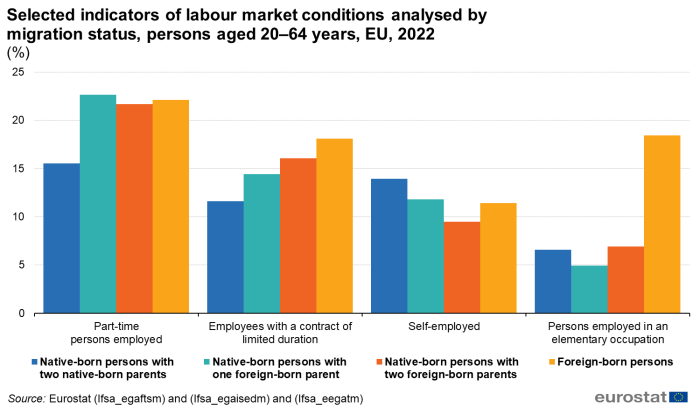
(%)
Source: Eurostat (lfsa_egaftsm) and (lfsa_egaisedm) and (lfsa_eegatm)
Across the EU, the share of employed persons working part-time in 2022 was 15.5 % for native-born persons with two native-born parents. This rate was notably higher for foreign-born persons or for descendants of foreign-born persons: 21.7 % for native-born persons with two foreign-born parents and 22.1 % for foreign-born persons, with a peak of 22.6 % for native-born persons with one foreign-born parent.
In the EU, 11.6 % of employees who were native-born persons with two native-born parents were employed with a contract of limited duration in 2022. This share was higher for foreign-born persons and for descendants of foreign-born persons, ranging from 14.4 % for native-born persons with one foreign-born parent to 18.1 % for foreign-born persons.
Across the EU, some 13.9 % of native-born persons with two native-born parents were self-employed in 2022. This share was lower for foreign-born persons and for descendants of foreign-born persons ranging from 11.8 % for native-born persons with one foreign-born parent to 9.5 % for native-born persons with two foreign-born parents.
The share of employed persons with an elementary occupation (for example, domestic helpers, refuse collectors, labourers in agriculture, mining, manufacturing, construction and transport) in the EU in 2022 ranged from 4.9 % to 6.9 % for native-born persons, depending on the country of birth of their parents. For foreign-born persons, the share was 18.4 %.
Table 1 below presents data for the same four indicators and the same four categories of migration status as in Figure 1. Each of these indicators is analysed in turn in the four main sections of this article.
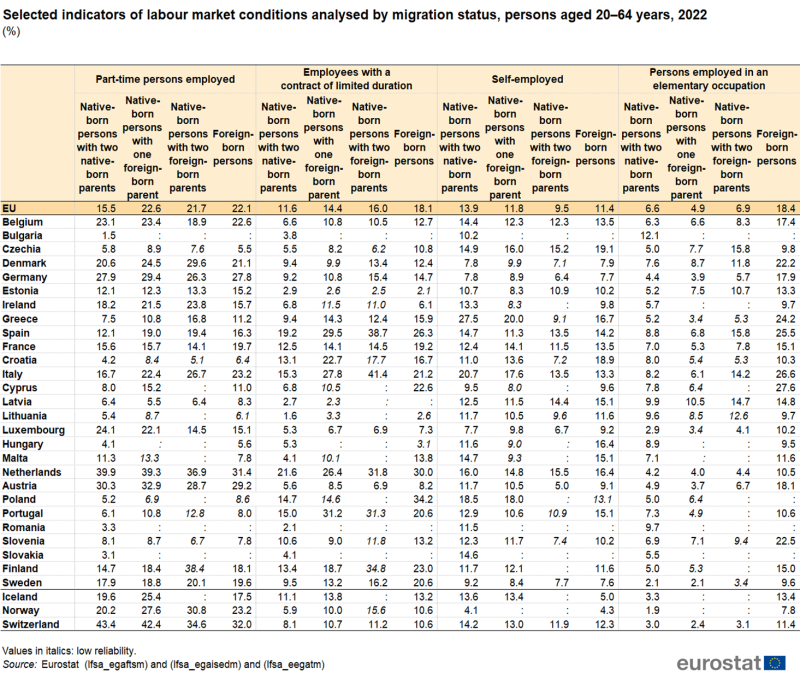
(%)
Source: Eurostat (lfsa_egaftsm) and (lfsa_egaisedm) and (lfsa_eegatm)
Part-time employment
In order to see the indicators for which the gap is greatest, the data in Figure 2 and similar figures later for employees under a contract of limited duration (Figure 5) and self-employment (Figure 8) have been normalised. The shares for each of the four categories of migration status have been divided by the share for native-born persons with two native-born parents. The values of the ratio for native-born persons with two native-born parents are equal by construction to 1.
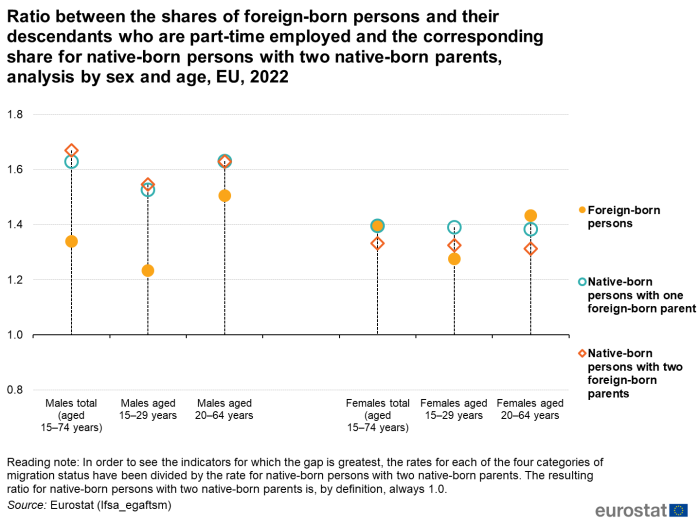
Source: Eurostat (lfsa_egaftsm)
Native-born persons with one or two foreign-born parents and foreign-born persons in the EU were more likely to be employed part time in 2022 than native-born persons with two native-born parents. This was observed regardless of sex for all three age groups shown in Figure 2: young people (aged 15–29 years), core working-age people (aged 20–64 years) and all people aged 15–74 years.
Among males in the EU, the highest value of ratio between the part-time shares in 2022 was observed for native-born males with one or two foreign-born parents. For foreign-born males, the part-time shares were somewhat lower, but still clearly above those for native-born males with two native-born parents. Among females, there was less variance in the part-time shares according to migration status among native-born persons with one or two foreign-born parents and foreign-born persons.
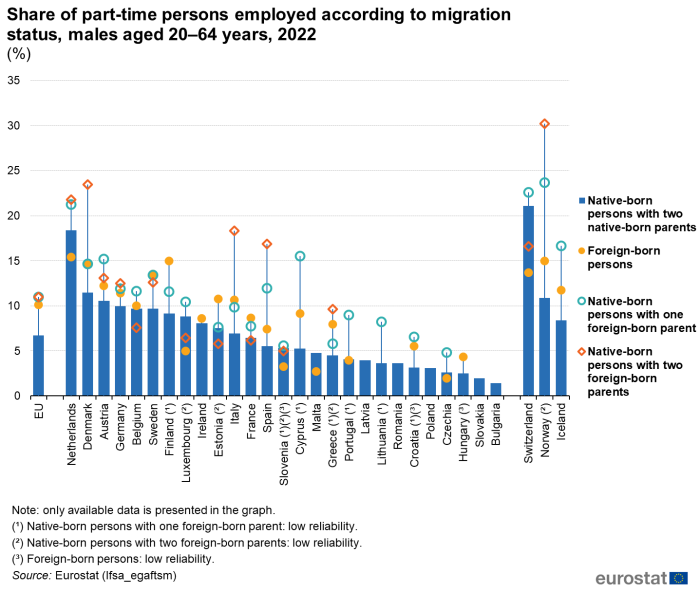
(%)
Source: Eurostat (lfsa_egaftsm)
For 13 EU Member States, data for all four categories of migration status are available for the share of part-time workers among total employment for males aged 20–64 years in 2022 (see Figure 3).
- Seven Member States (Denmark, Italy, Spain, Austria, Sweden, Germany and Greece) reported that native-born males with one or two foreign-born parents and foreign-born males had higher part-time shares than native-born males with two native-born parents.
- In the Netherlands, Luxembourg and Slovenia (low reliability), the part-time share was the lowest for foreign-born males.
- For the remaining three Member States – Belgium, France, Estonia - the lowest part-time share was observed for native-born males with two native-born parents.
In 2022, the largest differences (in percentage point terms) between the part-time shares for males of different migration status were observed in Denmark, Italy and Spain.

(%)
Source: Eurostat (lfsa_egaftsm)
For 17 EU Member States, data for all four categories of migration status are available for the part-time share in 2022 of females aged 20–64 years (see Figure 4).
- Italy, Greece, Spain, Czechia, Croatia (low reliability) and Latvia were the only EU Member States that reported that native-born females with one or two foreign-born parents and foreign-born females had higher part-time shares than native-born females with two native-born parents.
- The reverse situation – native-born females with two native-born parents having the highest part-time share – was observed in the Netherlands, Belgium, Sweden and Luxembourg.
- For the remaining seven EU Member States the situation was mixed, with the part-time share for some categories of foreign-born females and females with one or two foreign-born parents above the share observed for native-born females with two native-born parents and some below it.
In 2022, the largest differences between the part-time rates for females of different migration status were observed in the Netherlands, Greece and Luxembourg.
Employees with a contract of limited duration
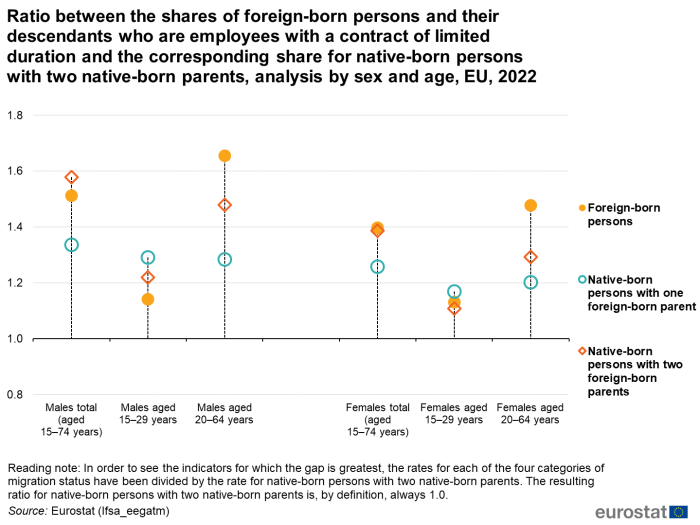
Source: Eurostat (lfsa_eegatm)
Native-born employees with one or two foreign-born parents and foreign-born employees in the EU were more likely to have a contract of limited duration in 2022 than native-born employees with two native-born parents. This pattern was observed regardless of sex for all three age groups shown in Figure 5: young people (aged 15–29 years), core working-age people (aged 20–64 years) and all people aged 15–74 years.
Among young employees (aged 15–29 years) in the EU, the value of ratio between the shares of employees with a contract of limited duration in 2022 was similar for foreign-born employees and native-born employees with one or two foreign-born parents. There was more variation in the ratios for the broader age groups (15–74 and 20–64 years).
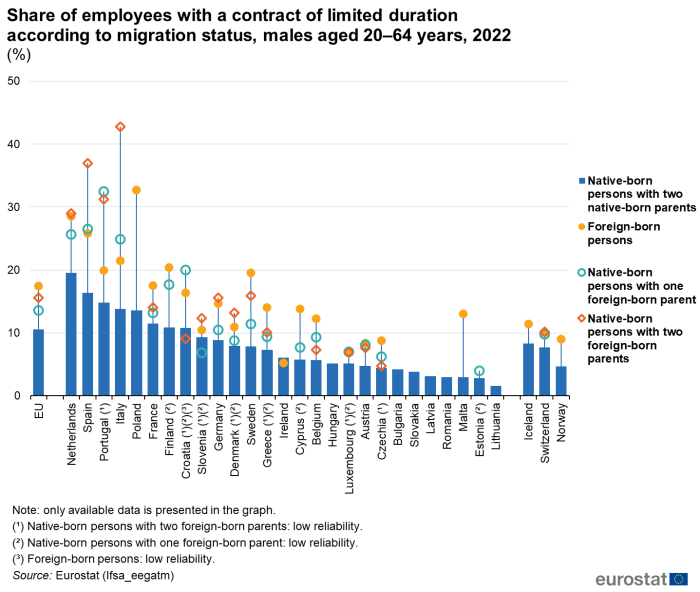
(%)
Source: Eurostat (lfsa_eegatm)
For 15 EU Member States, data for all four categories of migration status are available for the share of male employees (aged 20–64 years) who had a contract of limited duration in 2022 (see Figure 6).
- 13 EU Member States reported that native-born males with one or two foreign-born parents and foreign-born males had higher shares of employees with a contract of limited duration than native-born males with two native-born parents.
- In Croatia (low reliability), the lowest share of employees with a contract of limited duration was observed for native-born males with two foreign-born parents.
- In Slovenia (low reliability), the lowest share of employees with a contract of limited duration was observed for native-born males with one foreign-born parent.
In 2022, the largest differences (in percentage point terms) between the shares of employees with a contract of limited duration for males of different migration status were observed in Italy, Spain and Portugal.
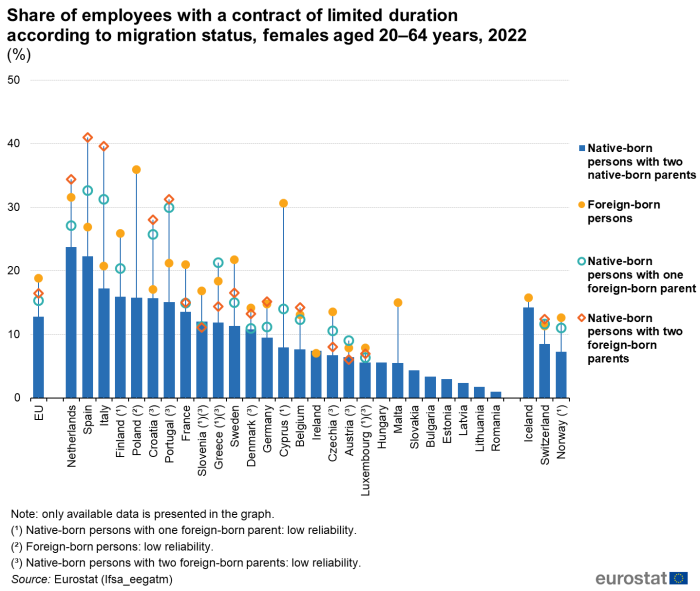
(%)
Source: Eurostat (lfsa_eegatm)
For 15 EU Member States, data for all four categories of migration status are available for the share of female employees aged 20–64 years with a contract of limited duration in 2022 (see Figure 7).
- 13 of the Member States that reported that native-born females with one or two foreign-born parents and foreign-born females had higher shares of employees with a contract of limited duration than native-born females with two native-born parents.
- In Austria (some data of low reliability), the lowest share of female employees with a contract of limited duration was observed for native-born females with two foreign-born parents.
- In Slovenia (some data of low reliability), native-born females with one or two foreign-born parents recorded shares below that of native-born females with two native-born parents.
Among EU Member States for which 2022 data covering all migration status are available, the largest differences between the shares of employees with a contract of limited duration for females of different migration status was observed in Spain Italy, and Portugal.
Self-employed persons
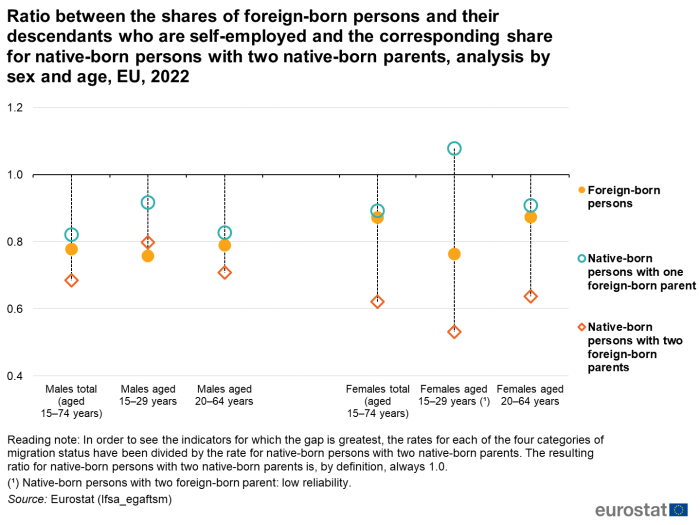
Source: Eurostat (lfsa_egaftsm)
Native-born persons with one or two foreign-born parents and foreign-born persons in the EU were generally less likely to be self-employed in 2022 than native-born persons with two native-born parents (Figure 1). This pattern was observed regardless of sex for the two broad age groups shown in Figure 8; core working-age people (aged 20–64 years) and all people aged 15–74 years. Among employed young people (aged 15–29 years), this pattern was also observed for males, whereas for young females the share of self-employment was slightly higher for native-born persons with one foreign-born parent than for native-born persons with two native-born parents.
For all presented age groups, among native-born persons with one or two foreign-born parents and foreign-born persons, there was greater variance among females than males in terms of self-employment shares according to migration status.
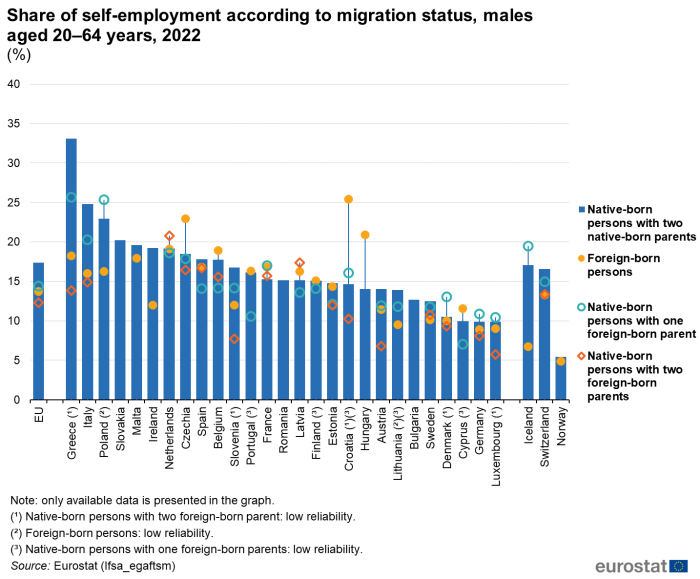
(%)
Source: Eurostat (lfsa_egaftsm)
For 16 EU Member States, data are available for 2022 for all four categories of migration status for the share of self-employed among total employment for males aged 20–64 years (see Figure 9).
- Seven Member States – Spain, Italy, Greece, Estonia, Sweden, Slovenia (low reliability) and Austria – reported that native-born males with one or two foreign-born parents and foreign-born males had lower shares of self-employment than native-born males with two native-born parents.
- The reverse situation – native-born males with two native-born parents having the lowest share of self-employment – was observed in France.
- In Czechia, Belgium and Croatia (low reliability), the highest shares of self-employment were observed for foreign-born males.
- In the remaining five Member States (and also in France), the highest shares of self-employment were observed for native-born males with one or two native-born parents.
In 2022, the largest difference (in percentage point terms) between self-employment shares for males of different migration status was observed in Greece and Croatia (low reliability).
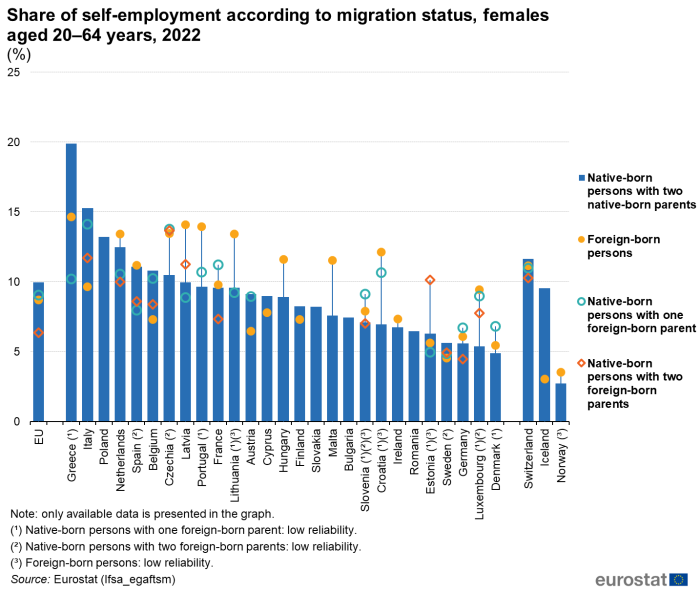
(%)
Source: Eurostat (lfsa_egaftsm)
For 12 EU Member States, data are available for 2022 for all four categories of migration status for the share of self-employed among total employment for females aged 20–64 years (see Figure 10).
- Italy, Belgium and Sweden (low reliability) reported that native-born females with one or two foreign-born parents and foreign-born females had lower shares of self-employment than native-born females with two native-born parents.
- The reverse situation – native-born females with two native-born parents having the lowest share of self-employment – was observed in Czechia and Luxembourg.
- For the remaining seven EU Member States the situation was mixed, with the self-employment share for some categories of foreign-born females and females with one or two foreign-born parents above the share observed for native-born females with two native-born parents and some below it.
Occupational structure of persons employed
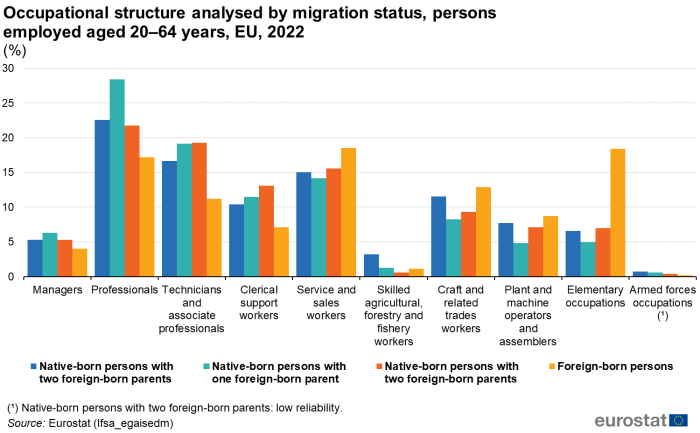
(%)
Source: Eurostat (lfsa_egaisedm)
Occupations can be classified according to the international standard classification of occupations (ISCO) into 10 major groups.
Figure 11 shows the share of each of the 10 major groups of occupations within total employment for 2022 for each of the four migration status analysed in this article.
- For the three native-born migration status, the three most worked occupations (in descending order) in the EU were the same: professionals; technicians and associate professionals; service and sales workers.
- For foreign-born persons, the most worked occupations were different. Service and sales workers were the most, followed by elementary occupations and then professionals.
- For all four migration status, the two least worked occupations (in ascending order) were the same (both including some low reliability data): armed forces occupations; skilled agricultural, forestry and fishery workers.
In relative terms, when analysed by migration status the shares of each occupation within total employment varied most for skilled agricultural, forestry and fishery workers. In 2022, this occupation accounted for 3.2 % of total employment in the EU among native-born persons with two native-born parents, which was 5.5 times as high as the share (0.5 %) recorded for native-born persons with two foreign-born parents.
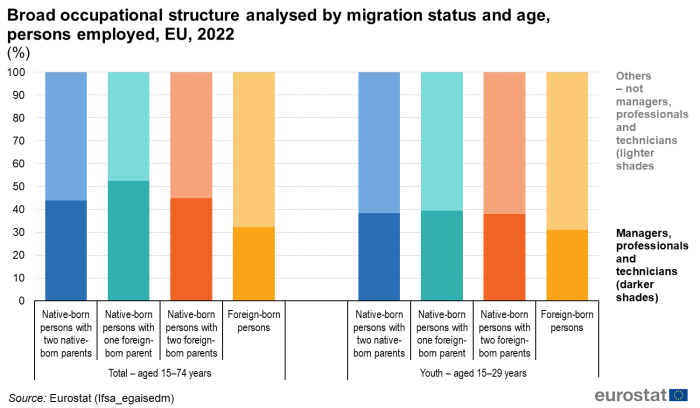
(%)
Source: Eurostat (lfsa_egaisedm)
For the remainder of this analysis by occupation (Figures 12–14 and Table 2), two aggregated categories of occupations are presented: managers, professionals and technicians are combined together and contrasted with an aggregate for the remaining seven major groups of occupations (classified under the heading of others).
Figure 12 shows a similar analysis to that in Figure 11, looking at the share of managers, professionals and technicians within total employment; it is presented for young people (aged 15–29 years) and for all people aged 15–74 years. For both age groups, the share of managers, professionals and technicians peaked among native-born persons with one foreign-born parent and was lowest among foreign-born persons.
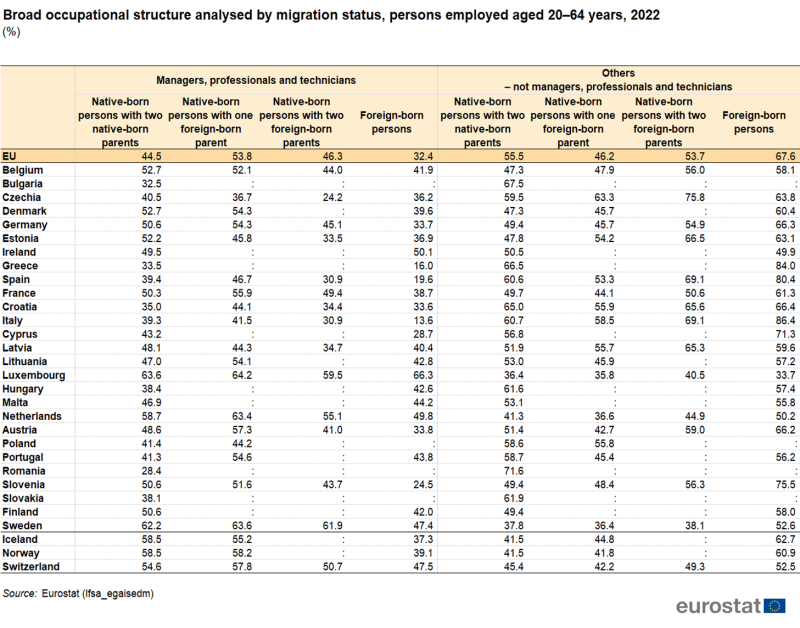
(%)
Source: Eurostat (lfsa_egaisedm)
Table 2 shows that more than half (53.6 %) of native-born persons with one foreign-born parent aged 20-64 years who were employed were managers, professionals and technicians, while this share was below one-third (32.4 %) for foreign-born persons.
For 14 EU Member States, data are available for 2022 for all four categories of migration status for the share of managers, professionals and technicians aged 20–64 years.
- Four EU Member States – Belgium, Czechia, Estonia and Latvia – reported that native-born persons with one or two foreign-born parents and foreign-born persons had lower shares of managers, professionals and technicians than native-born persons with two native-born parents.
- In Luxembourg, foreign-born persons had the highest share of managers, professionals and technicians.
- A remining nine EU Member States reported the highest shares of managers, professionals and technicians among native-born persons with one foreign-born parent.

(%)
Source: Eurostat (lfsa_egaisedm)
Figure 13 focuses on the gender balance among managers, professionals and technicians and for other occupations. This shows that there was a greater balance in 2022 for managers, professionals and technicians than for other occupations in the EU: the share of men (and therefore also of women) was closer to 50 % for managers, professionals and technicians than it was for other occupations.
In 2022, women accounted for a slight majority of all managers, professionals and technicians in the EU for native-born persons with two native-born parents and for native-born persons with two foreign-born parents; the reverse was true for native-born persons with one foreign-born parent and for foreign-born persons. Among other occupations, men were in a majority for all four migration status. For these other occupations, the largest share of men was for native-born persons with two native-born parents (56.7 %).

(%)
Source: Eurostat (lfsa_egaisedm)
Some general patterns can be observed that are common to all four migration status when comparing managers, professionals and technicians with other occupations in relation to educational attainment (Figure 14). The share of people with tertiary education was higher among managers, professionals and technicians than among other occupations. By contrast, among other occupations the shares were greater for people with at most, lower secondary education and for people with upper secondary or post-secondary non-tertiary education.
Looking at each of the two broad occupation categories in turn, the educational structures for the four migration status were similar, but not identical.
- The share of people with, at most, lower secondary education was highest in both broad occupation categories for foreign-born persons. Among managers, professionals and technicians, it was lowest for both native-born persons with two native-born parents and native-born persons with two foreign-born parents, while among other occupations it was lowest among native-born persons with one foreign-born parent.
- The share of people with upper secondary and post-secondary non-tertiary education was lowest in both broad occupation categories for foreign-born persons. Among managers, professionals and technicians, it was highest for native-born persons with two foreign-born parents while among other occupations it was highest among native-born persons with one foreign-born parent.
- The share of people with tertiary education was lowest in both broad occupation categories for native-born persons with two foreign-born parents. Among managers, professionals and technicians, it was highest for both native-born persons with one foreign-born parent and foreign-born persons, while among other occupations it was highest among native-born persons with one foreign-born parent.
Source data for tables and graphs
Data sources
The data presented in this article are from the labour force survey (LFS), the largest household sample survey in the EU. The survey covers the resident population, defined as all people usually residing in private households. As such, persons living in collective households are excluded from the target population. Usual residence means the place where a person normally spends the daily period of rest, regardless of temporary absences for purposes of recreation, holidays, visits to friends and relatives, business, medical treatment or religious pilgrimage. The data for the EU are aggregated results for the 27 EU Member States. For more information on the data sources used, please consult the online publication EU labour force survey.
Due to the sampling nature of the survey, some data have low reliability or are not published due to very low reliability or confidentiality. Data that are of low reliability are duly marked in the footnotes below the figures and tables.
Main concepts
An employed person is someone aged 15-89 years who, during the reference week of the survey, performed work – even if just for one hour a week – for pay, profit or family gain. Also included are people who were not at work but had a job or business from which they were temporarily absent.
An employee is a particular type of employed person. Employees work for a public or private employer and receive compensation in the form of wages, salaries, payment by results, or payment in kind; non-conscript members of the armed forces are also included. Employees are not self-employed or contributing family workers.
Self-employed persons are defined as persons who work in their own business (including professional practices, farms, shops and other businesses) for the purpose of earning a profit.
The distinction between full-time and part-time work is generally based on a spontaneous response by a respondent to the labour force survey.
An employee is considered as having a temporary job if employer and employee agree that its end is determined by objective conditions, such as a specific date, the completion of an assignment, or the return of an employee who is temporarily replaced: in such cases the employee has a contract of limited duration (as opposed to one of unlimited duration).
Occupations of employed persons are defined and classified in the international standard classification of occupations (ISCO). The occupations used in this article are based on ISCO-08. Elementary occupations include the following groups.
- Cleaners and helpers
- Agricultural, forestry and fishery labourers
- Labourers in mining, construction, manufacturing and transport
- Food preparation assistants
- Street and related sales and services workers
- Refuse workers and other elementary workers
Educational attainment refers to the highest level of education successfully completed. Educational levels are defined and classified in the international standard classification of education (ISCED). The levels of education used in this article are based on ISCED 2011. A low level of education refers to ISCED levels 0–2 (less than primary, primary and lower secondary education), a medium level refers to ISCED levels 3 and 4 (upper secondary and post-secondary non-tertiary education) and a high level refers to ISCED levels 5–8 (tertiary education).
Calculation of shares in totals
Thare shares have been calculated relative to a total including the number of people classified in the not stated or unknown categories.
Context
The data in this article provide information not only on foreign-born persons living in the EU but also about native-born persons with at least one foreign-born parent.
Successful integration may lead to economic and social benefits for migrants and for the society where they live. More information on the policies and legislation in force in this area can be found in an introductory article on migrant integration statistics.
Direct access to
Online publications
Methodology
- LFS ad hoc modules on migrants (mii_lfso)
- LFS series – Detailed annual survey results (ESMS metadata file – lfsa_esms)
- EU labour force survey